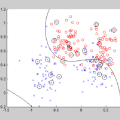Surface electromyogram (EMG) can be employed as an interface signal for various devices and software via pattern recognition. In EMG-based pattern recognition, the classifier should not only be accurate, but also output an appropriate confidence (i.e., probability of correctness) for its prediction. If the confidence accurately reflects the likelihood of true correctness, then it will be useful in various application tasks, such as motion rejection and online adaptation. The aim of this paper is to identify the types of classifiers that provide higher accuracy and better confidence in EMG pattern recognition. We evaluate the performance of various discriminative and generative classifiers on four EMG datasets, both visually and quantitatively. The analysis results show that while a discriminative classifier based on a deep neural network exhibits high accuracy, it outputs a confidence that differs from true probabilities. By contrast, a scale mixture model-based classifier, which is a generative classifier that can account for uncertainty in EMG variance, exhibits superior performance in terms of both accuracy and confidence.
翻译:肌电图(EMG)可以通过图案识别方法用作各种设备和软件的界面信号。在基于EMG的图案识别中,分类器不仅应该准确,还应该输出适当的置信度(即正确概率)。如果置信度能够准确反映真实正确性的可能性,那么它在各种应用任务中将是有用的,例如运动抑制和在线适应。本文的目的是识别在EMG图案识别中提供更高准确性和更好置信度的分类器类型。我们在四个EMG数据集上定性和定量评估各种判别和生成分类器的性能。分析结果表明,虽然基于深度神经网络的判别分类器展现出高的准确性,但它输出的置信度与真实概率不同。相比之下,一种基于比例混合模型的生成分类器,能够解释EMG方差中的不确定性,在准确性和置信度方面表现出优异的性能。



